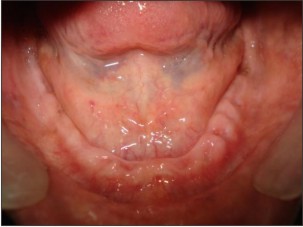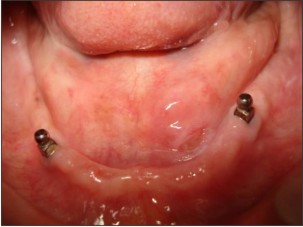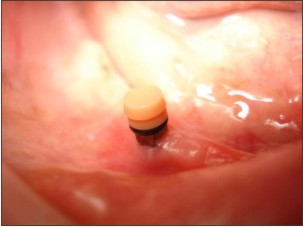Introduction
In modern dentistry implants play revolutionary role. Implant-retained overdentures can be a simple treatment option to restore the edentulous mandible.[1] Even full mouth oral rehabilitation can be done with the help of implants. In removable prosthesis implants are used for retention and stability. When height of residual ridge is low, then retention is compromised, but with the help of implants retention can be easily improved. The literature indicates that implant-supported overdentures in the mandible provide predictable results with improved stability, retention, function and patient satisfaction compared with conventional dentures. [2]
Case Report
A 55year old female patient reported to the department of prosthodontics, M.N. DAV dental college and hospital, Solan, Himachal Pradesh, with complaint of mandibular edentulous jaw and partially edentulous maxillary jaw. Her mandibular ridge had good bone volume and inverted U shape as in Figure: 1 and unable to provide good retention and support. So implant supported overdenture was planned. Implants are placed in her mandibular jaw in canine region as is shown in Figure: 2. Figure: 3 depicts o-ring with sleeve and complete mandibular denture was given to the patient as shown in Figure: 4. Removable partial denture was given in maxillary denture.
 | Figure: 1: Inverted U Shape Mandibular Ridge
 |
 | Figure: 2: Implants Are Placed In Canine Region
 |
 | Figure: 3: O-ring With Sleeve
 |
 | Figure: 4: Complete Mandibular Denture
 |
Discussion
Anterior alveolar ridge resorbs slower than posterior. So, in anterior region, ridge height is high and there is absence of any limiting structure. After first premolar mental foramen is present, from where mental nerve passes. Two implants were placed in canine region in this case. Positioning of the implants in canine region is better than positioning of implants in premolar region. Kennedy Class 1 patient with bilateral distal extensions and anterior missing teeth often are restored with a fixed partial prosthesis anteriorly and Class1 removable partial denture. This eliminates the unfavorable rocking leverages that exist when replacement denture teeth are anterior to the fulcrum line. If only two canines are remaining, a cross-arch tissue bar can be placed to gain favorable distribution forces. Likewise, independent implants in the premolar region allow greater amplitude of rocking of the restoration compared with implants in canine regions. When implants are placed in canine region, the anterior movement of the prosthesis is reduced, and the prosthesis even may act as a splint for the two implants, thereby decreasing some of the stress to each implant. [3]
When denture was placed on implants, soft liner was placed in denture to prevent the extra load on implants. After three months soft liner was replaced with o ring and sleeve. Three months time was taken for osseointegration. After osseointegration implants are ready for loading.
Summary & Conclusion
After one year, patient is happy with the denture. There is good retention and not any dislodgement of denture during any movement. An implant-retained complete lower denture is considered by many as the gold standard in the oral rehabilitation of the edentulous mandible. Its relative simplicity, minimal invasiveness, predictability, efficacy and affordability make it an attractive treatment option.[4] Mandibular implant-retained overdentures may be more satisfying for edentulous patients than new conventional dentures.[5] There are many good reasons why this treatment should be selected in preference to using fixed dentures. However, as with any treatment, there must be a strong commitment to after care if the overdenture is to remain successful.
References
1. Visser A, Meijer HJ, Raghoebar GM, Vissink A. Implant-retained mandibular overdentures versus conventional dentures: 10 years of care and aftercare. Int J Prosthodont. 2006; May-Jun; 19(3):271-8.
2. Doundoulakis JH, Eckert SE, Lindquist CC, Jeffcoat MK. The implant-supported overdenture as an alternative to the complete mandibular denture. J Am Dent Assoc. 2003; Nov; 134(11):1455-8.
3. Carl E. Misch. Treatment Options for Mandibular Implant Overdenture. P. 214.
4. Saha S, Ray-Chaudhuri A. Mandibular implant-retained complete overdenture using retentive abutments: a case report. Dent Update. 2009; Apr; 36(3):154-8.
5. Emami E, Heydecke G, Rompré PH, de Grandmont P, Feine JS. Impact of implant support for mandibular dentures on satisfaction, oral and general health-related quality of life: a meta-analysis of randomized-controlled trials. Clin Oral Implants Res. 2009; Jun; b20 (6):533-44.
|